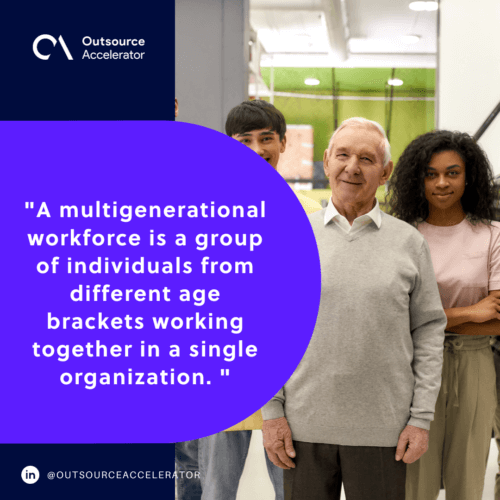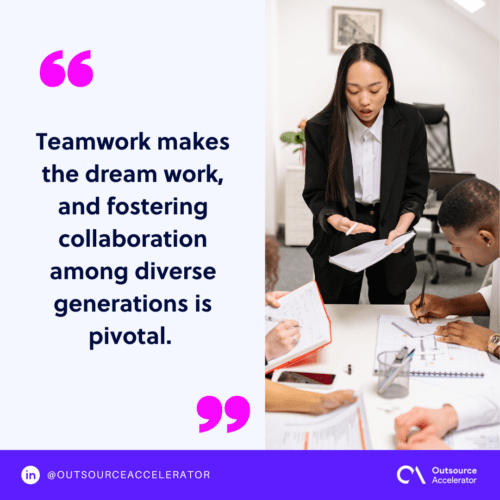What is a multigenerational workforce?

Have you noticed that workplaces are becoming more diverse regarding age groups?
It’s exciting to see Baby Boomers working alongside Millennials and Gen Z members. Each of them brings unique strengths, viewpoints, and challenges.
But what does having a multigenerational workforce mean?
In this article, we’ll explore the concept of a multigenerational workforce, its benefits, and challenges within an organization. We’ll also provide some tips for managing this diverse group of employees.
What is a multigenerational workforce?
A multigenerational workforce is a group of individuals from different age brackets working together in a single organization.
It means having Baby Boomers, Gen Xers, Millennials, and Gen Zers collaborating in the same workplace.
This combination creates different experiences, perspectives, and approaches. Societal changes and technological advancements of other times influence it.

Benefits of a multigenerational workforce
Having a multigenerational workforce in the workplace includes some benefits, such as:
Diverse perspectives
Imagine a workplace as a canvas and each generation as a unique color palette. In a multigenerational workforce, these diverse perspectives create various ideas and approaches:
- Baby Boomers bring years of experience
- Generation X adds stability
- Millennials infuse tech-savvy creativity
- Gen Z brings fresh perspectives
This blend enriches problem-solving and decision-making, providing more comprehensive and innovative solutions.
Knowledge sharing
In this diverse ecosystem, knowledge is currency. Seasoned professionals bring experience and wisdom, while younger employees offer up-to-date technological skills and innovative thinking.
This exchange isn’t just about passing on information; it’s a dynamic sharing of insights, lessons, and best practices that benefit the entire organization.
Mentorship opportunities
In a multigenerational workforce, mentorship isn’t a one-way street; it’s a mutual exchange of skills and wisdom.
Older employees can guide younger ones with their experience, while the younger generation can offer insights into the latest trends and technologies.
Increased adaptability
Change is the only constant, and a multigenerational workforce is the epitome of adaptability.
Younger generations often adapt quickly to new technologies and trends, while older ones provide stability and experience.
This fusion creates a resilient workforce capable of navigating any shifts in the market or industry landscape.

Enhanced communication skills
Think of communication in a multigenerational workforce as a blend of different languages. Each generation has its communication style, from face-to-face conversations to emojis and digital messaging.
Learning to navigate these diverse communication channels enhances everyone’s overall communication skills.
Challenges of a multigenerational workforce
Despite some benefits, a multigenerational workforce has the following drawbacks:
Communication barriers
Communication is like a dance, and in a multigenerational workplace, it’s a dance where each generation has its rhythm.
Different communication preferences, from face-to-face discussions to emails or instant messaging, can create misunderstandings or misinterpretations.
Conflicting work styles
Just as everyone has their preferred way of dressing, generations have distinctive work styles.
For example, Millennials might favor flexibility and technology, while Baby Boomers might value traditional structures and face-to-face interactions.
Different values and expectations
Each generation brings its values and expectations shaped by the era they grew up in.
Differences in attitudes toward work-life balance and views on career progression can create tensions within the workplace.
Resistance to change
Change can be daunting, especially for those accustomed to specific routines or technologies. Some employees, particularly from older generations, might resist adopting new tools or processes.
Management and leadership challenges
Managing a multigenerational team is like conducting an orchestra with musicians playing different instruments. Each generation requires a different approach to leadership and management.
Tips to manage a multigenerational workforce
Successfully managing a multigenerational workforce requires proactive strategies that embrace diversity, such as:
Encourage open communication
Communication is the cornerstone of a harmonious workplace. Encourage an open-door policy where individuals feel comfortable sharing their thoughts and ideas.
Implement communication channels like face-to-face discussions, emails, instant messaging, and team meetings to accommodate diverse communication preferences.
Creating a culture where everyone’s voice is heard fosters mutual understanding and respect among different generations.
Provide diverse learning opportunities
Learning is a lifelong journey, and a multigenerational workforce thrives on continuous growth.
Offer diverse learning platforms, from traditional classroom-style training to online modules and mentorship programs.
Catering to different learning needs ensures that every generation can:
- Acquire new skills
- Stay updated with the latest trends
- Grow personally and professionally.
According to a research led by Harvard Business Review, 68% of the companies surveyed have introduced training initiatives involving multiple generations.
These programs aim to manage generational disparities and foster teamwork among employees.
Emphasize shared goals and values
Alignment is the key to unity. Emphasize the company’s overarching goals and core values that resonate across all generations.
When employees, regardless of age, feel connected to a common purpose, it fosters a sense of belonging and collective ownership.
This alignment helps bridge the gap between differing perspectives and creates a unified front.
Flexible work arrangements
Flexibility is the new norm in the modern workplace. Provide adaptable work options like remote work, flexible scheduling, or condensed workweeks.
It empowers individuals to balance work commitments with personal life responsibilities. Providing this flexibility not only boosts morale but also enhances productivity.
Promote collaboration and team building
Teamwork makes the dream work, and fostering collaboration among diverse generations is pivotal.
Organize team-building activities that cater to different interests and preferences. It could range from volunteer programs to sports events or cross-generational mentorship initiatives.
Creating opportunities for interactions beyond work tasks strengthens relationships, builds trust, and enhances teamwork.

The impact of a multigenerational workforce
The impact of a multigenerational workforce transcends mere coexistence—it’s a strategic advantage.
Embracing and effectively managing this diversity fosters an environment where:
- Innovation thrives
- Adaptability becomes a strength
- Employee engagement soars
- Markets are better understood
- Decision-making becomes more robust
It’s not just about different generations working together; it’s about leveraging the unique strengths of each generation to propel the organization toward unparalleled success.







 Independent
Independent




